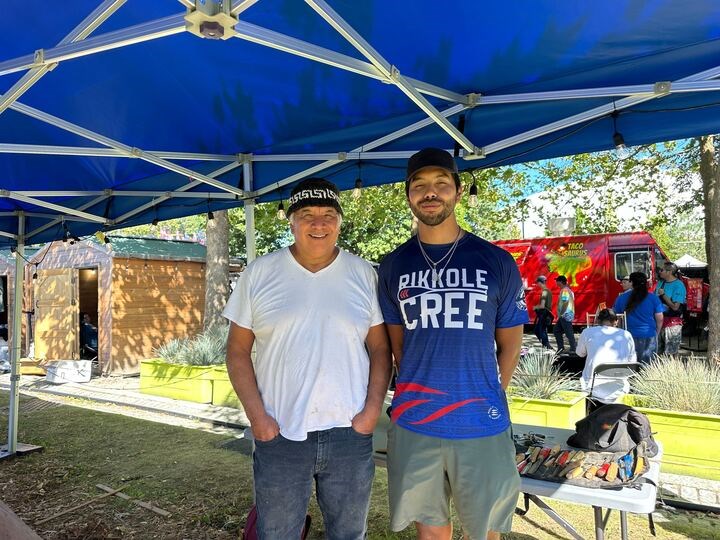"My dad had tree logs delivered to the front of his house. He took me and my brothers out there, and he said, 'I'll show you once and once only, and if you get it, you probably will, but if you don't, you probably never will.’”
For Mike Billy Sr., a seventh-generation canoe carver from the Sḵwx̱wú7mesh Úxwumixw (Squamish Nation), these words from his father were an introduction to the craft that he now continues as part of a long family tradition.
Along with his son, Mike Billy Jr., Billy Sr. continues the practice of canoe carving at the a two-day event that is part of the
The PNE Fair, running from Aug. 17 to Sept. 2 at Hastings Park in Vancouver, includes the Tatus Festival—named after the Nuu Chah Nulth word for "star"—focusing on Indigenous music, arts and culture. The festival offers Indigenous communities a platform to share their heritage with the public.
Billy Sr. is known for creating a significant fleet of new dugout and cedar strip canoes for local First Nations, including the North Shore Canoe Club. While teaching apprentices, guests and visitors about the traditions, tools and techniques involved in canoe carving, Billy Sr. also highlights the importance of this practice in the Skwxwú7mesh way of life.
“Canoe carving is a pretty neat thing because we were colonized in the 1800s, and they started residential schools in 1886,” said Billy Sr.
“But canoeing was considered a sport, and they liked to watch the races. The canoes themselves were our mode of transportation. We’re very lucky to have these traditions handed down from father to son.”
Legacy in Every Stroke
At the festival, Billy Sr. and his team are showing how to carve dugout and cedar strip canoes. He decides how the canoes are designed, plans the schedule, and chooses the apprentices. All activities respect Skwxwú7mesh cultural practices and include guidance from Elders.
“This isn’t just about making a canoe,” Billy Sr. said. “It’s about understanding our history, respecting our Elders and ensuring that these traditions are passed down to the next generation.”
Billy Jr., who is learning the craft from his father, commented on the importance of continuing these traditions. “It’s symbolic and really shows that our ways of living and our practices are truly passed down from father to son.”
Canoe carving has been a significant part of the Billy family’s history. Billy Sr. recalled his childhood memories of canoes and discussed the precision required in this craft.
“Building a canoe is a really tough thing. Everything has to be symmetrical and perfect, like within an eighth of an inch,” he said. The tools used in carving, some of which have been passed down through generations, hold particular significance.
“Some of the things my father handed down to me include a drawknife. It’s a curved drawknife, and I think they used it for carving benches or the grooves in chairs. He got it from his father, so I think it’s from the early 1800s, if not the early 1900s,” Billy Sr. said.
He added, “I also have an adze—one from my grandfather and one from my dad. My dad’s adze is more for carving. It’s still heavy and rugged, but my grandfather’s adze is a big, hefty tool, like the kind you’d imagine Vikings used. It knocks out big chunks of wood, like blocks, and that was handed down from my grandfather to me. Those tools are very special to me; I’ll never leave them anywhere, and I’ll always take care of them.”
An adze is like an axe, with an arched blade.
Spiritual Carving: More Than Wood
This spiritual connection to the land and sea is deeply rooted in .
Billy Sr. described the spiritual aspect of canoe carving. “You have to be in agreement with the log before you start chopping on it,” he said. “You can’t just start hitting it with an axe. You have to sit down with it and come to some sort of arrangement.”
When discussing his connection to Squamish, Billy Sr. noted, “My father is a hereditary chief, and his chieftainship bloodline came from Paradise Valley near Cheakamus, and that’s where our family comes from.”
Reflecting on his role in continuing his family’s legacy, Billy Sr. stated, “I think each artist has a different take on sharing their art and their knowledge. My dad was a great artist, and he was very giving. If you asked him a question, he’d tell you and show you. I try to be the same—I try to be giving and share as much as I can. I love canoe building, and I love canoe racing. For me, teaching it is just another part of that passion.”
Bhagyashree Chatterjee is The –°¿∂ ”∆µ’s Indigenous and civic affairs reporter. This reporting beat is made possible by the

.png;w=120;h=114;mode=crop)



